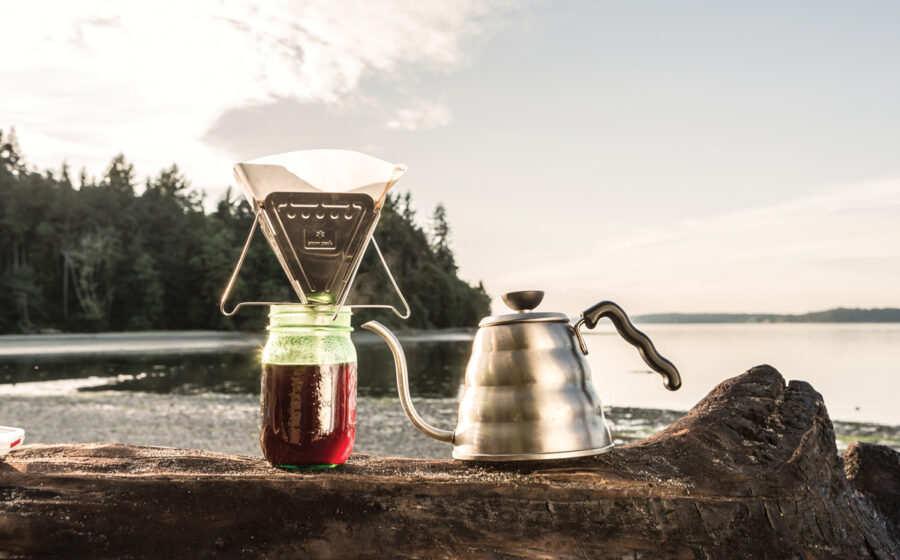[I]f you’re like us, you adore coffee, and what could be greater than enjoying a naturally processed Ethiopian brewed on the edge of the world? OK, maybe we’re not that extreme . . . yet.
Bethany and I met at a latte art throwdown in Portland, Oregon. Both of us were wide-eyed and looking for mentors to take our passion to the next step: competition. Bethany had her sights set on the United States Barista Championship. For me, it was the Brewer’s Cup.
Instead of finding mentors, we joined together to make learning an adventure. Bethany brought the idea to me and it was precisely the challenge I was looking for to prepare for the Brewer’s Cup. We decided to get outside, experience more of Oregon, and take the coffee with us. If we could conquer the challenge of brewing great coffee outdoors, then the challenges of competition would seem more achievable.
When we first set out on our adventure, we were so ambitious. We were going to brew every method, take lots of pictures—just get out of control with our coffee. We started a blog to document our outdoor brews. But we had so many ideas and so many directions that it took away from actually brewing really good coffee. We had a blast playing in the waterfalls; don’t get us wrong. However, we quickly became more serious about our trips. We gave them more purpose and focused on simplifying, so our coffee could reach its potential.
Brewing outdoors requires a lot of preparation, and depending on where you’re going and how far you’ll be walking, there are variables to consider: mostly distance, weight, bulk, and how much effort you want to put into your cup. Some trips require greater efficiency than others.
There are a few things you can do to make your outdoor brewing experience smoother. First, either bring along a familiar coffee scoop whose volume you know or pre-weigh your coffee. Second, know the volume of water you’re shooting for. Either fill your Aeropress to a specific point, or know the volume of your coffee cup or your kettle (or whatever you’re using to heat water). Third, have a stable camp stove and always bring backup fuel; nothing is sad in quite the same way as a brew cut short.
Here are some scenarios and brew setups based on what we learned—but experiment, learn, and find out what setup works best for you.
Brew scenario 1: Road trip
When you fill up your car with gas, run into the mini-mart and get some hot water. Your road trip buddy should have been grinding some pre-weighed coffee for the last mile or so. Brew some Aeropresses on the hood of your car.
Brew scenario 2: Backpacking
All you need for backpacking is an Aeropress or Snow Peak pour-over—both are light and packable. Just heat water in a pot and pour. For packability, a bag of ground coffee is hard to beat, so know how much weight your coffee scoop holds. If you’re Aeropressing, choose a recipe that lets you fill it up without worrying about water weight. If you’re pouring over using the Snow Peak, know how much volume your cup of choice holds, and fill it up. When there’s water left in the slurry, let it drain out back into nature. (Paper filters are biodegradable!)
Brew scenario 3: Picnic
This is the most flexible scenario, and one of the only times a Chemex outdoors isn’t the worst idea. Walking short distances or taking multiple trips means you can be as nerdy or as relaxed as you want with your brewing. Try a big batch of Chemex coffee or pack a Kalita Wave alongside your Aeropress and brew them simultaneously for a neat barbecue trick. If you have ice, this is a great chance to show your friends and family how awesome flash (Japanese) iced coffee tastes outdoors.
As we spent more of our time going outside and taking coffee with us, we found that half of what’s fun about brewing coffee is the community it creates. Inviting people on our outdoors brews, from within and without the coffee community, is ultimately what kept us seeking out adventure, finding new places to explore, and new mountains to brew atop. Best of all were the conversations we got to have with others on the trail. We discovered that the only things that are absolutely essential to a great outdoor brew are the coffee and a passion for it.
Some recommended gear (pick and choose):
• Gooseneck kettle
• Aeropress
• Kalita Wave
• Snow Peak drip brewer
• Hand grinder (Porlex or Hario)
• Tins for pre-dosed coffee
• Coffee scoop
• Gram scale
• Sturdy camp stove, backup fuel
• Senses of adventure and humor
—Bethany Hargrove and Megan O’Connell are both baristas living and working in Portland, Oregon. Photos by Will Foster.


















